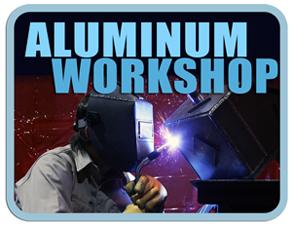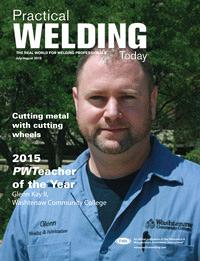President
- FMA
- The Fabricator
- FABTECH
- Canadian Metalworking
Categories
- Additive Manufacturing
- Aluminum Welding
- Arc Welding
- Assembly and Joining
- Automation and Robotics
- Bending and Forming
- Consumables
- Cutting and Weld Prep
- Electric Vehicles
- En Español
- Finishing
- Hydroforming
- Laser Cutting
- Laser Welding
- Machining
- Manufacturing Software
- Materials Handling
- Metals/Materials
- Oxyfuel Cutting
- Plasma Cutting
- Power Tools
- Punching and Other Holemaking
- Roll Forming
- Safety
- Sawing
- Shearing
- Shop Management
- Testing and Measuring
- Tube and Pipe Fabrication
- Tube and Pipe Production
- Waterjet Cutting
Industry Directory
Webcasts
Podcasts
FAB 40
Advertise
Subscribe
Account Login
Search
Aluminum Workshop: The real deal when welding aluminum and steel
- By Frank Armao
- July 23, 2015
- Article
- Aluminum Welding
Q: We fabricate small pressure vessels to ASME code. Up until now we have fabricated only steel tanks, but recently we’ve been given the opportunity to fabricate similar pressure vessels from aluminum. A few people have told us that we shouldn’t attempt to fabricate aluminum and steel components in the same building because the steel grinding dust can contaminate the aluminum. Others have told us that this should not be a problem. What’s the real story?
A: This is a myth that gets passed around regularly. First of all, most aluminum alloys contain about 0.50 percent iron, so it would be difficult to “contaminate” the aluminum. Second, in my younger days I worked for many years in a shop that fabricated both steel and aluminum pressure vessels. I will personally affirm that we never had any issue with iron contamination. So, the short answer to your question is that yes, aluminum and steel can be fabricated successfully in the same building, and even in the same bay of the building.
However, this isn’t to say that you shouldn’t take certain precautions. I think it is safe to say that aluminum is less tolerant of foreign contamination—not including iron—than steel is during welding. When I say “foreign contamination” I am referring to the particulates in your shop air, like oil mist, as well as the residue of oils, greases, and lubricants on your parts. In many shops the amount of contaminants floating around in the air, which might not cause a problem in welding steel, may cause a problem in welding aluminum. You must ensure that the aluminum is clean when you weld it, whether or not you are welding steel in the same plant. Here are a few ways you can do this:
- Clean the aluminum properly before welding. This usually means removing oils and greases with a degreasing solvent followed by wire brushing to remove oxides.
- Once the weld area is clean, perform the weld as soon as possible so that dirt or other contamination doesn’t infiltrate the weld area.
- If you can’t weld the joint right away (say, within 8 hours or so), cover the weld seam with heavy brown paper and tape it down so it doesn’t blow off.
- If you leave an unfinished weld over a weekend, cover it with brown paper.
If you take sensible precautions, you can weld steel and aluminum in the same space. If you are careless, you will have problems welding aluminum even if you aren’t welding steel nearby.
About the Author

Frank Armao
Aluminum Consulting Inc.
440-479-0239
About the Publication
Related Companies
subscribe now

The Welder, formerly known as Practical Welding Today, is a showcase of the real people who make the products we use and work with every day. This magazine has served the welding community in North America well for more than 20 years.
start your free subscription- Stay connected from anywhere

Easily access valuable industry resources now with full access to the digital edition of The Fabricator.

Easily access valuable industry resources now with full access to the digital edition of The Welder.

Easily access valuable industry resources now with full access to the digital edition of The Tube and Pipe Journal.
- Podcasting
- Podcast:
- The Fabricator Podcast
- Published:
- 04/16/2024
- Running Time:
- 63:29
In this episode of The Fabricator Podcast, Caleb Chamberlain, co-founder and CEO of OSH Cut, discusses his company’s...
- Trending Articles
Sheffield Forgemasters makes global leap in welding technology

ESAB unveils Texas facility renovation

Engine-driven welding machines include integrated air compressors

The impact of sine and square waves in aluminum AC welding, Part I

How welders can stay safe during grinding

- Industry Events
16th Annual Safety Conference
- April 30 - May 1, 2024
- Elgin,
Pipe and Tube Conference
- May 21 - 22, 2024
- Omaha, NE
World-Class Roll Forming Workshop
- June 5 - 6, 2024
- Louisville, KY
Advanced Laser Application Workshop
- June 25 - 27, 2024
- Novi, MI



























